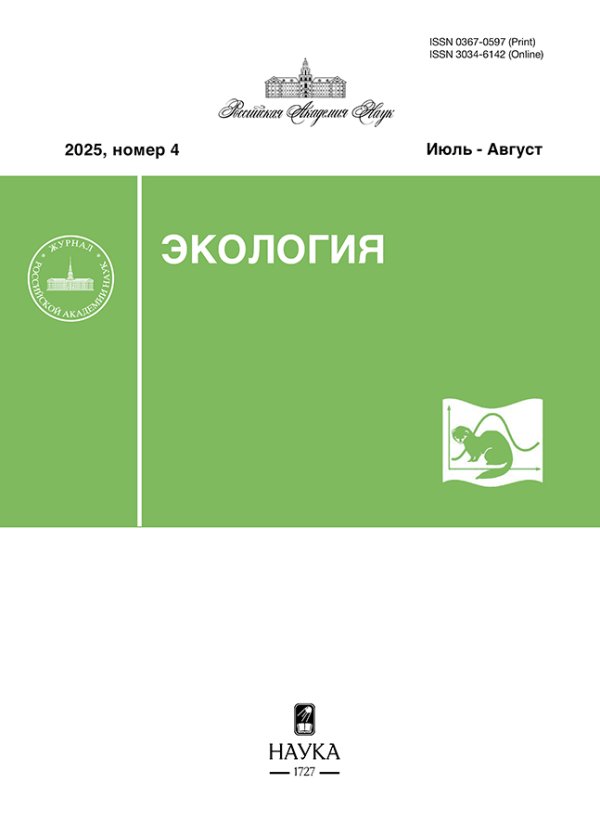Депонирование углерода лиственницей сибирской в экотоне верхней границы древесной растительности на полярном Урале
- Авторы: Михайлович А.П.1,2, Фомин В.В.1, Голиков Д.Ю.3, Агапитов Е.М.1, Рогачев В.Е.1, Мазепа В.С.4
-
Учреждения:
- Уральский государственный лесотехнический университет
- Уральский федеральный университет
- Ботанический сад УрО РАН
- Институт экологии растений и животных УРО РАН
- Выпуск: № 3 (2025)
- Страницы: 193-201
- Раздел: Статьи
- URL: https://journal-vniispk.ru/0367-0597/article/view/307681
- DOI: https://doi.org/10.31857/S0367059725030039
- EDN: https://elibrary.ru/tckfaa
- ID: 307681
Цитировать
Аннотация
В экотоне верхней границы древесной растительности исследованы взаимосвязи между значениями биометрических параметров лиственницы сибирской (средний радиус горизонтальной проекции кроны, диаметр дерева у шейки корня и его высота) с использованием данных наземных измерений на круговых пробных площадях и аэроснимков сверхвысокого пространственного разрешения, полученных при помощи беспилотного летательного аппарата. Созданы нелинейная регрессионная модель, модель с использованием метода «случайный лес» и ансамбль моделей с использованием методов машинного обучения, устанавливающие взаимосвязь значений диаметра у шейки корня от радиуса кроны экземпляра лиственницы сибирской. Полученные модели обладают высоким уровнем адекватности на качественном и количественном (R2> 0.95) уровнях. Предсказательные возможности модели нелинейной регрессии вне пределов обучающей выборки были лучше, чем у моделей машинного обучения, поэтому она была использована совместно с аллометрическими уравнениями для количественной оценки фитомассы лиственницы сибирской по величине диаметра у шейки корня и депонирования углерода на исследуемой территории по данным, полученным в результате дешифрирования крон 88 608 экз. лиственницы сибирской. Установлено, что в экотоне верхней границы древесной растительности на площади 7.32 км2величина надземной и подземной фитомассы лиственницы сибирской составляет 1355.2 т сухой массы, которая содержит 677.6 т углерода, или 2484.5 т CO2-эквивалента. EDN:tckfaa
Об авторах
А. П. Михайлович
Уральский государственный лесотехнический университет; Уральский федеральный университет
Email: a.p.mikhailovich@yandex.ru
Россия 620100 Екатеринбург, Сибирский тракт, 37; Россия 620062 Екатеринбург, ул. Мира, 19
В. В. Фомин
Уральский государственный лесотехнический университет
Email: a.p.mikhailovich@yandex.ru
Россия 620100 Екатеринбург, Сибирский тракт, 37
Д. Ю. Голиков
Ботанический сад УрО РАН
Email: a.p.mikhailovich@yandex.ru
Россия 620144 Екатеринбург, ул. 8 Марта, 202а
Е. М. Агапитов
Уральский государственный лесотехнический университет
Email: a.p.mikhailovich@yandex.ru
Россия 620100 Екатеринбург, Сибирский тракт, 37
В. Е. Рогачев
Уральский государственный лесотехнический университет
Email: a.p.mikhailovich@yandex.ru
Россия 620100 Екатеринбург, Сибирский тракт, 37
В. С. Мазепа
Институт экологии растений и животных УРО РАН
Автор, ответственный за переписку.
Email: a.p.mikhailovich@yandex.ru
Россия 620144 Екатеринбург, ул. 8 Марта, 202
Список литературы
- Shiyatov S.G., Terent’ev M.M., Fomin V.V.et al. Altitudinal and horizontal shifts of the upper boundaries of open and closed forests in the Polar Urals in the 20th century // Russ. J. Ecol. 2007. V. 38. P. 223–227. https://doi.org/10.1134/S1067413607040017
- Hagedorn F., Shiyatov S.G., Mazepa V.S.et al. Treeline advances along the Urals mountain range – driven by improved winter conditions? // Glob. Chang. Biol. 2014. V. 20. P. 3530–3543. https://doi.org/10.1111/gcb.12613
- Kharuk V.I., Im S.T., Dvinskaya M.L.Forest-tundra ecotone response to climate change in the Western Sayan Mountains, Siberia// Scand. J. For. Res. 2010. V. 25. P. 224–233. https://doi.org/10.1080/02827581003766959.
- Grigor’ev A.A., Devi N.M., Kukarskikh V. V.et al. Structure and Dynamics of Tree Stands at the Upper Timberline in the Western Part of the Putorana Plateau // Russ. J. Ecol. 2019. V. 50. P. 311–322. https://doi.org/10.1134/S1067413619040076
- Moiseev P.A., Galimova A.A., Bubnov M.O.et al. Tree Stands and Their Productivity Dynamics at the Upper Growing Limit in Khibiny on the Background of Modern Climate Changes // Russ. J. Ecol. 2019. V. 50. P. 431–444. https://doi.org/10.1134/S1067413619050084
- Dufour-Tremblay G., Lévesque E., Boudreau S.Dynamics at the treeline: Differential responses ofPicea marianaandLarix laricinato climate change in eastern subarctic Québec// Environ. Res. Lett. 2012. V. 7. Art. 044038. https://doi.org/ 10.1088/1748-9326/7/4/044038
- Mamet S.D., Brown C.D., Trant A.J.et al. Shifting globalLarixdistributions: Northern expansion and southern retraction as species respond to changing climate // J. Biogeogr. 2019. V. 46. P. 30–44. https://doi.org/10.1111/jbi.13465
- Kullman L.Rapid recent range margin rise of tree and shrub species in the Swedish Scandes // J. Ecol. 2002. V. 90. P. 68–77.
- Bryn A., Potthoff K.Elevational treeline and forest line dynamics in Norwegian mountain areas – a review// Landsc. Ecol. 2018. V. 33. P. 1225–1245. https://doi.org/10.1007/s10980-018-0670-8
- Camarero J.J., Gutiérrez E., Fortin M.-J.Spatial patterns of plant richness across treeline ecotones in the Pyrenees reveal different locations for richness and tree cover boundaries // Glob. Ecol. Biogeogr. 2006. V. 15. P. 182–191. https://doi.org/10.1111/j.1466-822x.2006.00211.x
- Bakker J., Olivera M.M., Hooghiemstra H.Holocene environmental change at the upper forest line in northern Ecuador // Holocene. 2008. V. 18. P. 877–893.
- Chhetri P.K.Predicting upslope expansion of sub-alpine forest in the Makalu Barun National Park, Eastern Nepal, with a hybrid cartographic mode // J. For. Res. 2018. V. 29. P. 129–137. https://doi.org/10.1007/s11676-017-0421-8
- Chiu C.-A., Lee M.-F., Tzeng H.-Y.et al. A concise scheme of vegetation boundary terms in subtropical high mountains // Afr. J. Agr. Res. 2014. V. 9. P. 1560–1570. https://doi.org/10.5897/AJAR2012.471
- Lenoir J., Svenning J.C.Climate-related range shifts – a global multidimensional synthesis and new research directions // Ecography (Cop.). 2015. V. 38. P. 15–28. https://doi.org/10.1111/ecog.00967
- Mohan M., Silva C.A., Klauberg C.Individual tree detection from unmanned aerial vehicle (UAV) derived canopy height model in an open canopy mixed conifer forest // Forests. 2017. V. 8. P. 1–17. https://doi.org/10.3390/f8090340.
- Peña J.M., de Castro A.I., Torres-Sánchez J.et al. Estimating tree height and biomass of a poplar plantation with image-based UAV technology // AIMS Agric. Food. 2018. V. 3. P. 313–323. https://doi.org/10.3934/AGRFOOD.2018.3.313
- Ahmadi S.A., Ghorbanian A., Golparvar F.et al. Individual tree detection from unmanned aerial vehicle (UAV) derived point cloud data in a mixed broadleaf forest using hierarchical graph approach // Eur. J. Remote Sens. 2022. V. 55. P. 520–539. https://doi.org/10.1080/22797254.2022.2129095
- Lin J., Chen D., Yang S.et al. Precise aboveground biomass estimation of plantation forest trees using the novel allometric model and UAV-borne LiDAR // Front. For. Glob. Chang. 2023. V. 6. Art. 1166349. https://doi.org/10.3389/ffgc.2023.1166349
- Shiyatov S.G., Terent’ev M.M., Fomin V.V.Spatiotemporal dynamics of forest-tundra communities in the Polar Urals // Russ. J. Ecol. 2005. V. 36. P. 69–75. https://doi.org/10.1007/s11184-005-0051-9
- Panova N.K., Jankovska V., Korona O.M.et al. Holocene Dynamics of Vegetation and Ecological Conditions in the Polar Urals // Russ. J. Ecol. 2003. V. 34. P. 19–230.
- Wong C.M., Lertzman K.P.Errors in estimating tree age: implications for studies of stand dynamics// Can. J. For. Res. 2001. V. 31. P. 1262–1271. https://doi.org/10.1139/cjfr-31-7-1262
- Elliott G.P., Kipfmueller K.F.Multi-scale Influences of Slope Aspect and Spatial Pattern on Ecotonal Dynamics at Upper Treeline in the Southern Rocky Mountains, U.S.A // Arctic, Antarctic, and Alpine Research.2018.V. 42.P. 45–56. https://doi.org/10.1657/1938-4246-42.1.45
- Мазепа В.С., Шиятов С.Г.Динамика верхней границы леса на Полярном Урале в связи с изменениями климата // Вопросы географии: Исследования гор. Горные регионы Северной Евразии. Развитие в условиях глобальных изменений. 2014.V. 137.C. 290.
- Devi N.M., Kukarskih V. V., Galimova A.A.Climate change evidence in tree growth and stand productivity at the upper treeline ecotone in the Polar Ural Mountains // For.Ecosyst. 2020. V. 7. P. 1–16. https://doi.org/10.1186/s40663-020-0216-9.
- Методика количественного определения объема поглощений парниковых газов от 27.05.2022 № 371 / [Электронный ресурс].—URL: https://docs.cntd.ru/document/350962750 (датаобращения: 20.10.2024).
- Random Forest Regression: When Does It Fail and Why? // neptune.ai URL: https://neptune.ai/blog/random-forest-regression-when-does-it-fail-and-why (дата обращения: 09.05.2025).
- Hengl T., Nussbaum M., Wright M.N.et al. Random forest as a generic framework for predictive modeling of spatial and spatio-temporal variables // PeerJ. 2018. V. 6. Art. e5518.
- https: //doi.org/10.7717/peerj.5518
- Усольцев В.А., Часовских В.П., Норицина Ю.В.и др. Аллометрические модели фитомассы деревьев для лазерного зондирования и наземной таксации углеродного пула в лесах Евразии: сравнительный анализ // Сибирский лесной журн. 2016. № 4. С. 68–76. https://doi.org/10.15372/sjfs20160407
- Усольцев В.А., Цепордей И.С., Норицин Д.В.Аллометрические модели биомассы деревьев лесо- образующих пород Урала // Леса России и хозяйство в них. 2022. № 1. С. 4–14. https://doi.org/10.51318/fret.2022.85.72.001
- Фомин В.В., Рогачев В.Е., Агапитов Е.М.и др. Депонирование углерода основными лесообразующими древесными породами карбонового полигона Свердловской области // Леса России и хозяйство в них. 2024.№4.С. 3–15.
- Su R., Du W., Ying H.et al. Estimation of Aboveground Carbon Stocks in Forests Based on LiDAR and Multispectral Images: A Case Study of Duraer Coniferous Forests// Forests. 2023. V. 14. Art. 992.
- https: //doi.org/10.3390/f14050992
- Juan-Ovejero R., Elghouat A., Navarro C.J.et al. Estimation of aboveground biomass and carbon stocks ofQuercus ilexL. saplings using UAV-derived RGB imagery // Ann. For. Sci. 2023. V. 80.P. 1–24. https://doi.org/10.1186/s13595-023-01210-x
Дополнительные файлы










